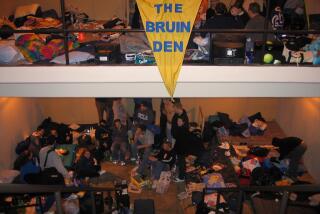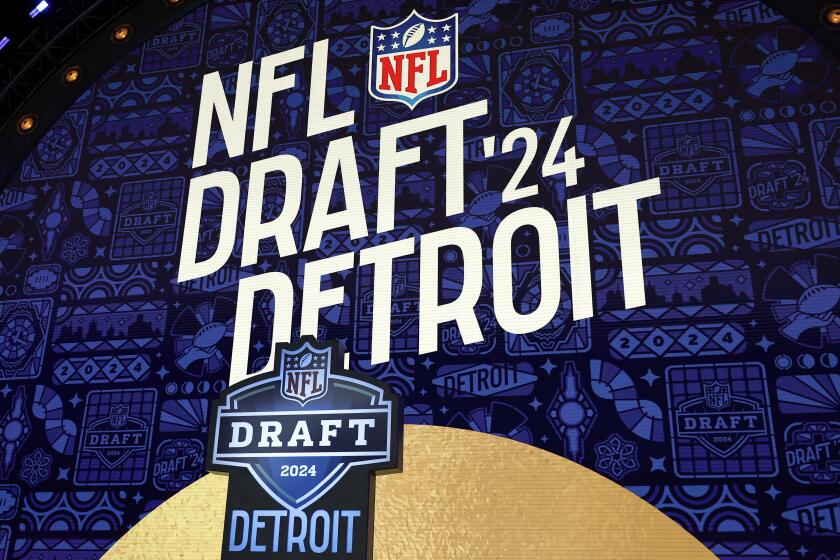Pauley Pavilion plays catch-up

Matthew Pauley relishes the sense of history inside Pauley Pavilion, the Westwood arena made possible in large part by a $1-million donation from his grandfather to UCLA during the early 1960s.
But the third generation of Pauleys to cheer on the Bruins also worries that the building risks becoming as dated as a Lew Alcindor sky hook.
“Pauley has unbelievable name recognition, and my preference would be to always keep that tradition,” said the 38-year-old investment banker who watched his first Bruins basketball game as a toddler and sits in the seats once occupied by his grandfather Edwin W. Pauley. “But I realize what the economics of college sports are, and that the building itself doesn’t live up to today’s standards of what spectators expect.”
The fact that “Big Ed” Pauley’s grandson is open to UCLA’s athletic department adding a corporate naming-rights partner underscores the spiraling costs and expectations associated with collegiate athletics since Pauley Pavilion opened in 1965 -- with a $5-million price tag.
Changes in store for Pauley could go well beyond a new name. University officials are discussing plans that range from a modest face-lift to an extreme makeover.
But talk of even tinkering with the building where John Wooden’s teams made basketball history has created divisions in Bruin Nation. Some say the 38 NCAA championships won by Pauley’s basketball, volleyball and gymnastics teams prove that, with a few nips and tucks, the arena can remain competitive with such newer facilities as USC’s $146-million Galen Center.
Others suggest that more radical measures, even construction of a new venue on the crowded Westwood campus, be considered.
“It would be awfully hard to put all the things they want to into that building, and make it work without effectively tearing it down,” said former UCLA Chancellor Charles Young, who oversaw Pauley’s design and construction.
UCLA Athletic Director Dan Guerrero says that an extensive renovation -- perhaps completed in phases -- is the preferred alternative.
Officials have yet to produce a detailed plan or a timetable for the proposed renovation. That hasn’t stopped a high-powered group of alumni and boosters from raising cash and commitments of $40 million so far in a drive that is expected to clear $100 million. And, earlier this month, a new architect was hired to refine the proposed renovation.
Pauley’s deficiencies clearly are evident to fans who struggle with uneven aisle steps, inadequate bathrooms and meager food concessions. UCLA also acknowledges the need to improve handicapped access, stay current with earthquake codes and upgrade aging electrical and mechanical systems.
Guerrero is considering a project that could cost more than $200 million, the price tag calculated by an architectural firm last year based upon an extensive wish list submitted by the multipurpose arena’s many tenants.
That list included upgraded locker rooms for athletes, coaches and officials, improved weight and training facilities, additional office and meeting space and a practice court. Guerrero, however, cautioned that the initial study was but one stop along the way.
“It would be nice to push the button and go all the way to the penthouse, but that’s not how it works,” Guerrero said. “It’s a fluid process. We have to raise the money, make sure we remain on point with everything and make sure we don’t hit any snags along the way.”
NBBJ, the newly hired sports architecture firm that designed Staples Center, will produce detailed designs that Guerrero’s team could use to “showcase” the proposed renovation to the UCLA community.
Fundraising committee member Bob Wilson, a San Diego businessman who served as chairman of the recent Campaign UCLA drive that netted more than $3 billion, acknowledged that some potential donors want to see a model before signing on the dotted line: “We don’t need full working drawings, but we do need some preliminary plans, some eyewash that people can see and say ‘yeah, that looks great, I’m in.’ ”
Committee chairman Richard A. Bergman, a long-time fundraiser for UCLA’s School of Letters and Science, also acknowledged the divide: “There are those who see the vision, who have confidence that it can be done . . . and another group that wants to see what it’s going to look like before they get excited.”
UCLA administrators also are hearing from longtime Bruin donors whose past financial support was rewarded with lifetime seats for basketball games -- a right that in some cases can be passed along to a surviving spouse.
“We need to be very transparent, to communicate up front,” said Ross Bjork, the UCLA senior associate athletic director who is charged with raising funds for the Pauley project -- and balancing the needs of new and potential donors against “the loyalty and longevity of someone who’s had tickets for a long time.”
Compromises made
Pauley’s limitations date back to the early 1960s when UCLA hired architect Welton Becket -- whose work includes the Sports Arena, Mark Taper Forum and Parker Center -- to design a multipurpose arena to accommodate intercollegiate athletics, intramural sports and special events.
Becket originally envisioned a building akin to the Sports Arena, which opened in 1959, with a concourse that would have included more bathrooms, concessions stands, a main entrance and athletic department offices. But compromises were made. “We had to cut corners because we didn’t have the money,” Young said in a recent interview.
Now, Guerrero talks of “value engineering” rather than cutting corners.
Last year’s Pauley wish list included a new practice court. But it might make sense, Guerrero now says, to delay construction of the proposed practice facility and work with the university on a separate, underground structure to serve both intercollegiate and intramural athletics.
Simply bulldozing Pauley to make way for a new arena would be difficult “because of Pauley’s long, skinny footprint,” said local architect David Body, who studied possible renovations prior to the 1984 Summer Games. “You can’t put a [modern] square arena in there.”
And, unlike the University of Oregon, which is on the verge of getting state legislative approval to issue $200 million in bonds for its proposed arena, UCLA will have to rely largely upon donations -- which is where Matthew Pauley enters the picture.
There has been no discussion of adding a corporate logo to the John and Nell Wooden Court. And Guerrero said that “there may be one or two individuals out there who will donate significant dollars to preserve” the Pauley name. But, early on, Guerrero contacted the Pauley family to determine if members would support a corporate naming rights agreement if it made financial sense.
“My view is that it’s an economic deal,” Pauley said. “We all realized that in a perfect world, we’d go out and find the dollars needed and build it. But if isn’t possible, there are sponsorships and different things that can raise money.”
As the architectural review and fundraising progress, many alumni tend to agree that the university can’t afford a design or fund-raising misstep.
“Dan Guerrero has built a world-class athletic department and to continue to sustain that level of excellence [requires] world-class facilities,” said UCLA graduate and sports industry executive Casey Wasserman. “As a school that never will have its own football stadium that can generate significant revenue, Pauley Pavilion is our only chance to do so. And we will only get the chance to bring Pauley up to par once.”
More to Read
Get our high school sports newsletter
Prep Rally is devoted to the SoCal high school sports experience, bringing you scores, stories and a behind-the-scenes look at what makes prep sports so popular.
You may occasionally receive promotional content from the Los Angeles Times.






